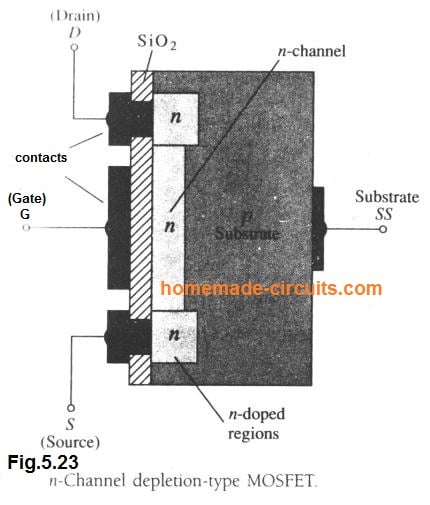These N-channel enhancement mode field effect transis-tors are produced using ON Semiconductor's proprietary, high celldensit yDMOS technology. These, products have beendesigned to minimize on-state resistance while providingrugged, reliable, and fast switching performance. Theycan be used in most. Smart Filtering. As you select one or more parametric filters below, Smart Filtering will instantly disable any unselected values that would cause no results to be found. Applied Filters: Semiconductors Discrete Semiconductors Transistors MOSFET. Transistor Polarity = N-Channel Channel Mode = Enhancement. N-channel MOS (NMOS) logic uses n-channel MOSFETs to implement logic gates and other digital circuits. For devices of equal current driving capability, n-channel MOSFETs can be made smaller than p-channel MOSFETs, due to p-channel charge carriers ( holes ) having lower mobility than do n-channel charge carriers ( electrons ), and producing only one type of MOSFET on a silicon substrate is cheaper. If an n-channel, enhancement-mode MOSFET were switching a positive-polarity voltage to a grounded load, the output would be limited to V GG ± V th. The equations describing performance of the n-channel ground-switching MOSFET with a ground-reference gate drive. Figure-4 depicts drain characteristics and transfer curve of enhancement type of MOSFET(N-channel). As shown in the figure-4 minimum threshold voltage is needed for the flow of drain current to start. This type of FET is ideal for switching application. This is due to the fact that no gate voltage is needed to keep the device in 'off' state.
difference between Depletion MOSFET vs Enhancement MOSFET
This page on Depletion MOSFET vs Enhancement MOSFET mentions difference between Depletion MOSFET and Enhancement MOSFET.
Depletion MOSFET
Figure-1 depicts construction of depletion type MOSFET. It also mentions circuit symbol of N-channel MOSFET of depletion type.Due to its construction if offers very high input resistance (about 1010 to 1015).Significant current flows for given VDS at VGS of 0 volt.
When gate(i.e. one plate of capacitor) is made positive, the channel((i.e. the other plate of capacitor) will have positive chargeinduced in it. This will result into depletion of majority carriers(i.e. electrons) and hence reduction inconductivity. Hence the curve similarto JFET is obtained as shown in the figure-2.
As shown in the symbol here gate is insulated from the channel.For P-channel type MOSFET symbol, arrow will be reversed.
Figure-2 depicts drain characteristics and transfer curve of depletion type of MOSFET(N-channel).
Enhancement MOSFET

Figure-3 depicts construction of enhancement type MOSFET. It also mentions circuit symbol of N-channel MOSFET of enhancement type.Here continuous channel does not exist from source to drain. Hence no current flows at zero gate voltage.Symbol depicts broken channel between 'S' to 'D' terminals.

When positive voltage is applied to the gate, it will induce a channel by flowing minority carriers(i.e. electrons) fromP-type bulk into the concentrated layer.

Figure-4 depicts drain characteristics and transfer curve of enhancement type of MOSFET(N-channel).As shown in the figure-4 minimum threshold voltage is needed for the flow of drain current to start.
This type of FET is ideal for switching application. This is due to the fact that no gate voltage is needed to keepthe device in 'off' state. Moreover the device can be powered ON with the application of same polarity as drain terminal.
Following are the important comparison features between Depletion and Enhancement MOSFET types:
• Enhancement MOSFET does not conduct at 0 volt, as there is no channel in this type to conduct.Depletion MOSFET conducts at 0 volt. Moreover when positive cut-off gate voltage is applied to depletion MOSFET,hence it is less preferred.
• The depletion MOSFET does not have any kind of leakage currents such as gate oxide and sub threshold type.
• Depletion MOSFET logic operations are opposite to enhancement type of MOSFETs.
• Diffusion current(i.e. sub-threshold leakage current) exists in enhancement MOSFET whiledepletion MOSFET do not have any diffusion current.
Comparison between NMOS and PMOS types
Refer NMOS vs PMOS which mentions comparison between NMOS and PMOS type of MOSFETs.

Difference between JFET and MOSFET
Refer JUGFET vs MOSFET which mentions difference between JFET and MOSFET.
What is difference between
BJT vs FET
Diac vs Triac
LED vs Laser
Photo Diode vs Photo Transistor
Halfwave rectifier vs Fullwave rectifier
N Channel Transistor
RF and Wireless Terminologies
Share this page
N-channel Enhancement Mosfet

N Channel Mosfet Operation
Translate this page
